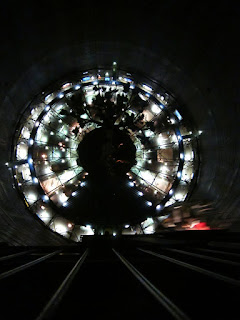BARCELONA UPDATE - OCTOBER '11
Here is how the system works. Member fees, parking fees, city subsidies and advertising revenue together fund this $13 million a year program. Riders pay an annual fee to get a magnetic smart card. They are charged 30 euros a year for the membership, then each time they rent a bike it's 30 cents for every half hour (the first half hour is always free). Given the number of stations available (375 according to this article) that makes the cost pretty reasonable for the average user. Costs are spread out with the city taking the lion's share. Getting more bikes on the road is happening through some creative avenues. Thankfully, it doesn't require that we all buy $1,500 bikes and wear spandex.
AMSTERDAM UPDATE - SEPT '11
As expected, Amsterdam was the penultimate bicycle Mecca. The temple is the bike storage shed by VMX Architects in front of Central Station that reportedly houses some 7,000 bikes! There are bike paths to all parts of the city. Trains allow bikes on board, trams and buses do not. The bus and tram are served by islands in the middle of the road. Passengers cross the bike path to board.
Of particular interest was the abundant use of motorized scooters on the bike path. These obey the same traffic laws as bikes, but move much quicker. Some electric scooters are so quiet that they sneak up on you before you have time to turn your head. The other amusing vehicle on the bike path is the electric mini car. Smaller than a golf cart and fully enclosed, the drivers behind these chariots I saw were in the senior age bracket.
As you can imagine these paths get quite crowded. There is an understanding and respect on the road for all means of transport. Trams and buses know to look for bikes and pedestrians. Bikers respect traffic signals and the cars are seemingly a non-entity. This symphony of movement on a busy city corner can be remarkable to watch.
COPENHAGEN has it worked out on a totally different plane. BIKES=CARS. They have their own lanes, separate from pedestrians and vehicles. Bus stops are typically on islands between the bike lane and the car lane. Bikes, have street lights, turn arrows and these nifty rails on stairways to bridges and overpasses (when they don't have a devoted ramp).
Bikes are parked everywhere. The city can't keep up with the demand, but its not as if there is parking for cars and not bikes. I have seen one parking structure and literally thousands of bike racks.
The trains devote half of a car to bikes, strollers and wheelchairs. The car and the pavement on the platform are clearly marked. One or two residents saw fit to clearly mark this car for their own purposes.
I took a ride into Copenhagen city center this morning. The ride was safe. Drivers watched for bikers and there was little confusion as to where the bike lanes were routed. A susbstantial construction project is underway on the Town Hall Plaza (Radhus Pladsen). The bike lane is maintained right through the middle of the site and roped off as it emerges on to the street.
This is a model worth replicating.
LONDON
With bike lanes on the busiest roads and full width bike lanes at the thorny intersections, bikes aren’t exactly ruling the road, but they have a place in London.
Barclays has teamed with the Mayor of London and is building brand new "cycle superhighways". They have implemented a bikes for hire program that is catching on in the Westminster and surrounding burroughs. I was staying outside the zone and usually had two kids in tow, so couldn't make much use of them. I did see their bikes on Clapham, right down the street from our flat.
The bikes are locked in their rack, you pay a pound to rent them for 1/2 hr. The rate goes up quickly after that with steep fines for late drop-off. They are designed to be ridden from point A to B and their are enough of these kiosks around that the scheme makes sense for certain trips.
The bikes are locked in their rack, you pay a pound to rent them for 1/2 hr. The rate goes up quickly after that with steep fines for late drop-off. They are designed to be ridden from point A to B and their are enough of these kiosks around that the scheme makes sense for certain trips.
Check out their fun video at this site:






















































